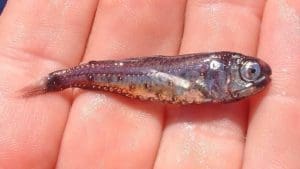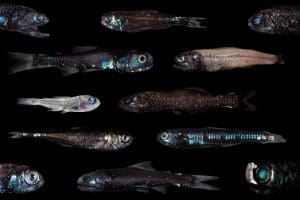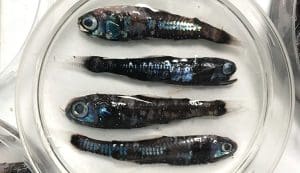
Welcome to the intriguing world of “The Strange Case of the Lanternfish.” In the depths of the ocean, a mysterious creature lurks, captivating scientists and enthusiasts alike. The lanternfish, with its mesmerizing bioluminescence and enigmatic nature, has puzzled researchers and sparked curiosity for years.
Join us as we delve into the depths to unravel the secrets behind this extraordinary fish and explore its fascinating characteristics, peculiar behaviors, and its significance within the marine ecosystem. Prepare to embark on a journey that will shed light on “The Strange Case of the Lanternfish” and leave you captivated by the wonders of the ocean’s depths.
Contents
What is a lanternfish?🐟
A lanternfish is a type of deep-sea fish that belongs to the family Myctophidae. These small, slender fish are found in oceans around the world, inhabiting the mesopelagic zone, which is the middle layer of the ocean depths. They are aptly named for their unique ability to produce light, or bioluminescence, using specialized light-emitting organs called photophores.
Lanternfish have streamlined bodies and typically range in size from a few centimeters to about 15 centimeters in length. They have large eyes that are adapted to low light conditions, allowing them to navigate and locate prey in the dark depths of the ocean. Their bodies are often silver or black, providing effective camouflage in the dimly lit environment.
One of the most fascinating aspects of lanternfish is their bioluminescence. They have an intricate arrangement of photophores along their bodies, which emit light in various patterns and colors. This bioluminescent display serves multiple purposes, including attracting prey, communicating with other lanternfish, and potentially confusing predators.
Discovery of the lanternfish.🐟
The discovery of the lanternfish is a fascinating tale that involves the exploration of the mysterious depths of the ocean. Throughout history, scientists and explorers have ventured into the vast expanses of the sea, driven by a curiosity to uncover the hidden wonders of marine life.
The initial discovery of lanternfish can be attributed to the efforts of marine researchers and oceanographers who employed various methods to explore the depths. Early expeditions utilized trawling nets, submersibles, and advanced imaging technologies to capture images and specimens of previously unknown marine species.
As scientists delved deeper into the ocean, they began to encounter a plethora of strange and mesmerizing creatures, including the lanternfish. The first documented sightings and collections of these peculiar fish sparked great interest and further investigations.
Surprising characteristics and adaptations.🐟
Lanternfish possess a range of surprising characteristics and adaptations that have captivated scientists and nature enthusiasts alike. These unique traits enable them to thrive in the challenging environment of the deep-sea.
One of the most remarkable features of lanternfish is their ability to produce light, known as bioluminescence. They possess specialized light-producing organs called photophores, which are scattered across their bodies. By controlling these photophores, lanternfish can emit light in a variety of patterns and colors. This bioluminescent display serves multiple functions, including attracting prey, camouflaging themselves, and communicating with other members of their species.
These adaptations have allowed lanternfish to thrive in the challenging and competitive environment of the deep-sea. Their bioluminescent abilities, keen senses, migration behavior, and streamlined bodies all contribute to their survival and successful navigation of the complex marine ecosystem.
Behavior and life cycle.🐟
Lanternfish exhibit intriguing behaviors and undergo a fascinating life cycle that allows them to thrive in their deep-sea habitat. Understanding their behavior and life cycle provides valuable insights into their ecology and reproductive strategies.
Lanternfish are known for their vertical migration, wherein they undertake daily movements between the depths of the ocean during the day and the surface waters at night. During the day, they remain in the darker, deeper regions of the ocean to avoid predation and conserve energy. As darkness falls, they ascend towards the surface to feed on small prey, such as plankton and other zooplankton.
Reproduction in lanternfish typically occurs through external fertilization. When it’s time to reproduce, males and females release their eggs and sperm into the water column simultaneously. This synchronized spawning behavior increases the chances of successful fertilization. Once fertilized, the eggs hatch into larvae, which are typically transparent and possess large eyes.
Interaction with humans.🐟
The interaction between lanternfish and humans is relatively limited due to their deep-sea habitat and the challenges associated with studying and accessing these environments. However, there are a few notable aspects of their interaction with humans that are worth exploring.
Scientific Research:
Lanternfish have been the subject of scientific research and study, particularly in the fields of marine biology and oceanography. Scientists are intrigued by their unique adaptations, bioluminescence, and vertical migration patterns. By studying lanternfish, researchers can gain valuable insights into the ecology and functioning of deep-sea ecosystems.
Commercial Fishing:
While lanternfish are not typically targeted for direct human consumption, they do play a role in commercial fishing activities. These fish are often caught incidentally as bycatch in deep-sea fisheries targeting other commercially valuable species. However, the overall impact of lanternfish fishing on their populations and ecosystems is not well understood.
Bioluminescence Research:
The bioluminescence of lanternfish has attracted interest for its potential applications in various scientific fields. Researchers study the mechanisms and properties of their bioluminescence to develop new technologies, such as bioluminescent imaging probes and tools for biomedical research.
Environmental Indicators:
Lanternfish, along with other deep-sea organisms, can serve as indicators of the health and ecological conditions of deep-sea ecosystems. Changes in their populations or behaviors can provide insights into the impacts of human activities, such as climate change and deep-sea mining, on these fragile environments.
Importance for the ecosystem.🐟
Lanternfish play a crucial role in the marine ecosystem, despite their small size and relatively unknown nature. As important members of the deep-sea community, they contribute to the functioning and balance of the ecosystem in various ways.
Firstly, lanternfish act as vital links in the marine food web. They feed on small organisms like plankton and zooplankton, effectively transferring energy from primary producers to higher trophic levels. Their abundance and widespread distribution make them a significant food source for larger predatory fish, marine mammals, and seabirds. By serving as a nutritious prey item, lanternfish support the survival and reproductive success of these higher-level predators, contributing to the overall biodiversity and stability of the ecosystem.
Additionally, lanternfish exhibit vertical migration behavior, moving between the deep-sea and surface waters. This behavior has a cascading effect on the distribution of energy and nutrients throughout the water column. As lanternfish rise to the surface at night to feed, they bring energy from deeper regions to shallower waters. This movement helps to redistribute nutrients, contributing to the productivity of surface waters and influencing the distribution and abundance of other organisms.


